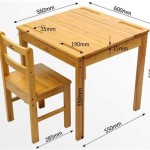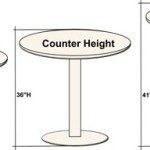```html
The Appeal and Application of Low Sitting Dining Tables
Low sitting dining tables represent a shift away from conventional dining room furniture, embracing a more relaxed and grounded approach to shared meals and social gatherings. Characterized by their reduced height, these tables encourage a posture that is closer to the floor, often paired with floor cushions, low benches, or legless chairs. The appeal of low sitting dining tables extends beyond mere aesthetics; they offer a unique blend of cultural influence, practical benefits, and adaptable design options.
The following discussion will delve into the origins, advantages, and considerations surrounding the incorporation of low sitting dining tables into various living spaces.
Historical and Cultural Context
The concept of low sitting dining has deep roots in various cultures, particularly in Asia. In Japan, the tradition of sitting on tatami mats at low tables (chabudai) is deeply ingrained in their history and culture. Similarly, in Korea, low tables are common in traditional homes, reflecting a connection to the earth and a sense of communal dining. These traditional dining arrangements emphasize closeness, intimacy, and a connection to the natural world.
The adoption of low-sitting dining tables in Western cultures often signifies an appreciation for these traditions and a desire to incorporate a more relaxed and informal dining experience. The aesthetic is often associated with minimalism, bohemianism, or a general embrace of Eastern-inspired design principles. The appeal lies in creating a space that feels less formal and more inviting, fostering a sense of community and connection among diners.
Furthermore, the evolution of low-sitting dining can be traced to practical considerations. In smaller living spaces, low tables can provide a versatile solution, serving as dining areas, coffee tables, or even workspaces. Their adaptability contributes to their increasing popularity in modern, space-conscious homes.
Advantages of Low Sitting Dining Tables
Beyond their aesthetic appeal and cultural significance, low sitting dining tables offer several practical advantages that contribute to their growing popularity. These benefits range from spatial efficiency to ergonomic considerations.
One primary advantage is space optimization. Low tables, when paired with floor cushions or low seating, can create a more open and airy feel in a room. They occupy less vertical space compared to traditional dining sets, making them ideal for apartments, studios, or any space where maximizing the sense of spaciousness is desired. This reduced vertical footprint allows for greater flexibility in room layout and furniture arrangement.
Another significant advantage lies in their inherent versatility. A low-sitting dining table can easily transition between different functions. During mealtimes, it serves as a dining surface. Outside of mealtimes, it can be used for games, crafts, or simply as a place to relax and socialize. The lack of rigid formality allows for greater spontaneity and adaptability in how the space is used.
From an ergonomic standpoint, low sitting can, under certain conditions, promote better posture. While prolonged unsupported sitting on the floor can strain the back, utilizing cushions or supportive low chairs can encourage a more upright spinal alignment. This can be particularly beneficial for individuals who tend to slouch in traditional chairs. However, it is crucial to maintain proper posture and use appropriate support to avoid discomfort or potential physical issues.
Finally, the informal nature of low-sitting dining environments can foster a more relaxed and intimate atmosphere. By removing the physical barrier of a higher table, diners are often encouraged to interact more freely and openly. This can be particularly appealing for casual gatherings or for families seeking to create a more connected dining experience.
Considerations When Choosing a Low Sitting Dining Table
While low sitting dining tables offer many benefits, careful consideration must be given to various factors to ensure a comfortable and functional dining experience. These considerations include table height, seating options, material choices, and the overall aesthetic of the space.
The optimal height of a low sitting dining table is crucial for comfort and functionality. A general guideline is that the table should be approximately 12-16 inches high. This height allows most individuals to comfortably reach the table while sitting on the floor or on low cushions. However, personal preferences and physical capabilities should be taken into account. It's recommended to test out different heights to find the most ergonomic option for individual needs.
The choice of seating is equally important. Options range from floor cushions to low benches to legless chairs. Floor cushions offer a casual and versatile option, allowing for flexibility in seating arrangement. Low benches provide a more structured seating solution, while legless chairs offer back support and a more traditional seating experience at a lower height. The selection should be based on personal comfort preferences, the overall aesthetic of the space, and the intended use of the table. Using supportive cushions or chairs with good lumbar support is crucial for maintaining proper posture and preventing discomfort.
The material of the table should be chosen based on durability, aesthetics, and maintenance requirements. Wood is a popular choice for its natural beauty and durability. Metal tables offer a sleek and modern look, while glass tables can create a sense of spaciousness. The material should also be resistant to spills and stains and easy to clean, especially if the table will be used frequently for dining. The finish should also be considered; a matte finish can hide scratches and fingerprints more effectively than a glossy finish.
The overall aesthetic of the low sitting dining table should complement the existing décor of the space. Whether the goal is to create a minimalist, bohemian, or traditional atmosphere, the table should integrate seamlessly with the surrounding furniture and accessories. Consider the color palette, textures, and overall style of the room when selecting a table. The choice of accompanying accessories, such as tableware, placemats, and candles, can further enhance the desired aesthetic.
Finally, accessibility is a key consideration. Low-sitting dining may not be suitable for individuals with mobility issues or back problems. It is essential to ensure that all users can comfortably access the table and maintain a comfortable posture. Consider providing alternative seating options for guests who may find low-sitting uncomfortable.
```
Buy Solid Wood Japanese Style Low Dining Table With Breakfast Set In Latest Sets Collection Saraf Furniture

Low Dining Table Laura Cornman Room Small Living Rooms Floor Seating

Space Saving Dining Table Ideas For Your Home Design Cafe

Goyalinterior Sheesham Wood Japanese Low Height Dinner Table And Chair Set For Livingroom Home Solid 6 Seater Dining In Buy

Diy Floor Table Home And Family

Buy Solid Wood Japanese Style Low Dining Table With Breakfast Set In Latest Sets Collection Saraf Furniture

Comfortable Low Seating Dining Table With 4 Stool Now

17 Best Low Dining Table Ideas

Comfortable Low Seating Dining Table With 4 Stool Now

33 Modern Floor Sitting Dining Table Design Japanese Room Ideas








